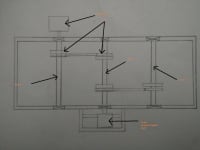ABSTRACT:
In this project we aim at storing and utilising the energy which is generally wasted in the form of heat, during braking action of vehicle. When brakes are applied, heat is generated, but this energy can be utilised in some form. There are various systems available to to store and utilise this energy. But all these systems first convert the mechanical form of energy to other forms of energy and then utilise it.
We have proposed a system which stores the mechanical energy itself and utilise this energy during pick-up of the vehicle.
COMPONENTS USED:
Pair of C.V.T Pulleys (Continuously Variable Transmission)
Shafts
Frame
Pulley Belts
Compressor
Pneumatic Wrench
WORKING:
It is clear from the Diagram attached that-
When brakes are applied the C.V.T on Shaft-1 comes into action. This C.V.T engages Shaft-1 with compressor shaft i.e. Shaft-2. This engagement helps to provide braking action along with the energy being stored into the compressor in the form of compressed air.
Now,when the vehicle is stopped and brake paddle is released Shaft-1 and Shaft-2 gets disengaged.
Now,when the accelerator paddle is pressed, the compressed air from the compressor is made to flow through a hose to turbine which will be mounted on Shaft-3. This helps to return the power absorbed during braking, back to Propeller shaft. The C.V.T on Shaft-3 is engaged at this point and the power from Shaft-3 is transmitted to Shaft-1.
In this way the energy initially stored, is now returned back to the propeller shaft. This energy helps to accelerate the vehicle without increasing the load on the vehicle engine, which helps in the reduction of fuel consumption at the time of pickup and hence decreasing in over all fuel consumption of vehicle and Increasing mileage.
This will work in normal braking circumstances where braking and acceleration is done slowly.
Sensors and controllers are installed to let the vehicle work without this system in extreme circumstances i.e during sudden stopping of vehicle and rapid acceleration.
MERITS:
1 )Improved fuel economy - dependent on duty cycle, powertrain design, control strategy and
the efficiency of the individual components.
2) Emissions reduction - engine emissions reduced by engine decoupling, reducing total
engine revolutions and total time of engine operation (engine on - off strategy).
3) Improved performance.
4) Reduction in engine wear - engine on/off strategy.
5) Reduction in brake wear -reducing cost of replacement brake linings, cost of labor to install them and vehicle down time.
6) Smaller accessories - hybrid powertrain offers potential for eliminating (electric starter) or downsizing (fuel tank) some accessories, thus partially offsetting the increased vehicle weight and cost due to the hybrid hardware additions.
7) Operating range is comparable with conventional vehicles – a problem not yet overcome by electric- vehicles.
DEMERITS:
1) Added weight.
2) Increased Complexity.
3) Safety Concern- High Energy Density Storage device poses a threat to safety.
4) Added Cost.
Like this entry?
-
About the Entrant
- Name:Alekh Jain
- Type of entry:teamTeam members:Alekh Jain Ankit Bhamdare Anirudh Raghuwanshi Shreyansh Choudhary
- Software used for this entry:CREO
- Patent status:none





